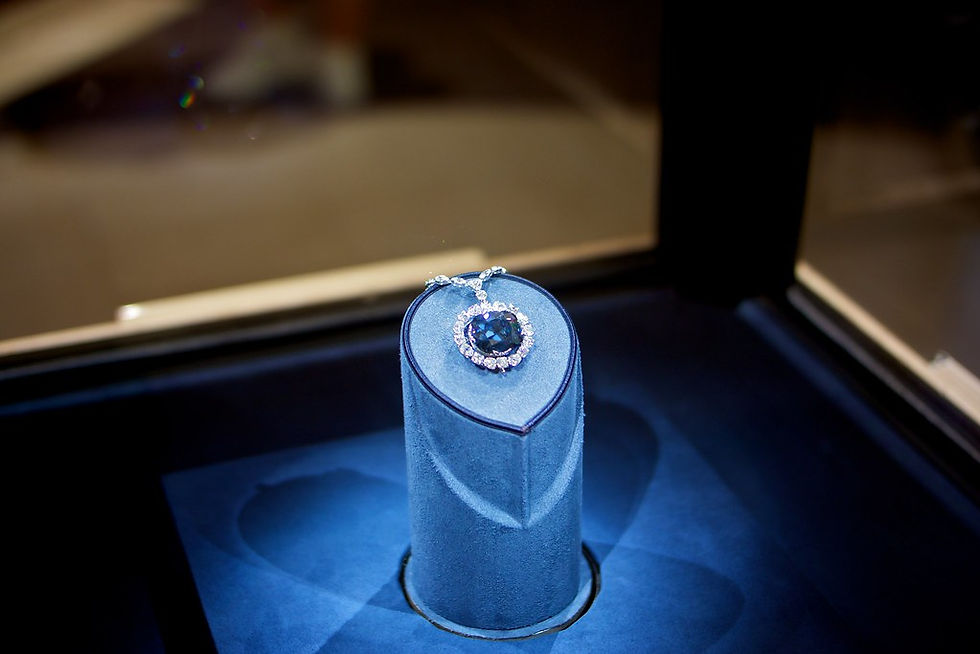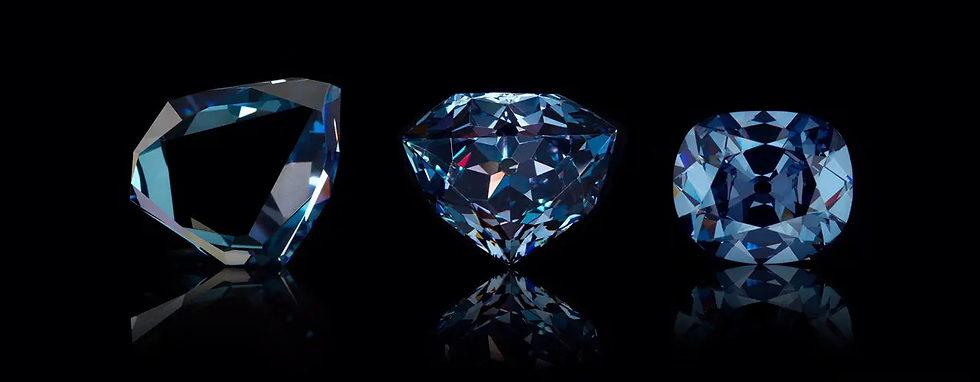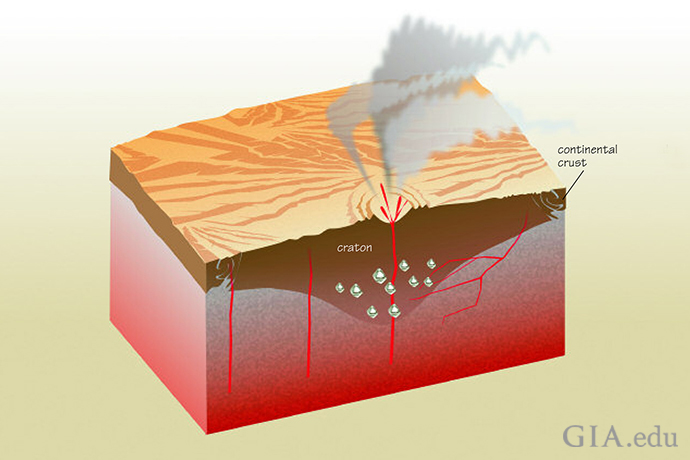
Distinguishing Features
Diamonds are the hardest material on earth: 58 times harder than anything else in nature.
The average yield in most diamond mines is 1 part diamond to 1 million parts host rock.
Most diamonds formed more than a billion years ago, deep in the earth’s mantle.
The Most Desirable Picks
A diamond's value is based on its own unique combination of the Four Cs: clarity, color, cut and carat weight.

For a comprehensive guide on diamond quality factor, please visit the developer of the Four Cs system, the Gemological Institute of America (GIA) website : Diamond Quality Factors (gia.edu)
Origins

The map above shows countries estimated to have at least 100,000 carats of natural gem-quality diamond production in 2021. Map by Magnificent-international.com. Data from USGS Mineral Commodity Summaries 2022.
Thanks to the advances in exploration technology, natural diamond production occurs in many part of the world now. There are a few regions and deposits that have significant importance to the world's diamond production landscape.
Asia:
India was the world's only major diamond source until the 18th century. in the late 1900s, the country's diamond industry shifted from mining to manufacturing.
The People's Republic of China became a source when alluvial diamonds were discovered there in 1940s, a few mining sources appears through 1960s to 1990s. The diamonds produced in China are relatively small and and mostly remain for domestic gem cutters or industrial uses.
South America:
Brazil replaced India as the world's main source of diamonds in 1730 and kept that position until 1870, when production started in South Africa. Until very recently , Brazil's diamond supply was exclusively alluvial. Starting from 2013, production began at commercially viable kimberlite pipe- The Liapari mine.
Africa:
Africa has he most diverse diamond sources due to a wide range of geographic features. Pipes, alluvial supplies and marine deposits are all legendary and plentiful to uphold its position to the industry, the abundance of resource also suggest a promising future.
South Africa is the discovery place of diamonds, the first deposit discovered between 1869 and 1871 were clustered around the town of Kimberly. The mines formed the basis of De Beers Consolidated Mines Ltd., marked the birth of the modern diamond industry. South African mines used to produce 95 percent of total world production from before 1903. Today it account for only 0.7 percent. Three of the most important mines are Cullinan, Finsch and Venetia.


In Namibia, the world's most important marine deposit lies along the Atlantic coast of Africa. The inland countries of central Africa- Botswana, Angola, and the Democratic Republic of Congo, as well as Guinea, Serra Leone, Ghana and Tanzania in west and east Africa are also participants in Africa's diamond production.
Russia
Russia's diamond sources are almost all primary, Mining conditions in Russia's Siberian diamond fields are among the toughest on earth because of hostile climates and almost inaccessible location.
Australia
The Argyle mine in Western Australia is an important source of the tiny diamonds used in inexpensive mass-produced jewelry, but also some high quality fancy colour diamonds, especially pinks. The asset ceased mining activity on November 3, 2020.
Canada
Canada's mines tend to be smaller but richer in diamond per ton of ore than pipes elsewhere in the world. South African mines average 40 carats per 100 tons, but one Canadian pipe yielded 62 carats from 50 metric ton sample.
Ekati and Diavik mines are economically viable because each contains many small, closely situated diamond pipes with enough diamond bearing ore. Snap Lake is the first mine in the world to begin underground operation without an open-pit stage. Other operating mines in Canada include Gahcho Kue, Jericho Pipe and Victor. Some additional mines are likely to join the list, making Canada potentially a very significant contributor to the world's natural diamond production.
Significant Pieces
The Hope Diamond:
Rough weight 110.50 cts.
Modern weight: 45.52 cts.
Shape: Cushion
Colour: Fancy Deep grayish blue
Clarity: VS1

The history of the stone which was eventually named the Hope Diamond began when the French merchant traveler, Jean Baptiste Tavernier, purchased a 112 3/16-carat diamond. This diamond, which was most likely from the Kollur mine in Golconda, India, was somewhat triangular in shape and crudely cut. Its color was described by Tavernier as a "beautiful violet."
Tavernier sold the diamond to King Louis XIV of France in 1668 with 14 other large diamonds and several smaller ones. In 1673, the stone was recut by Sieur Pitau, the court jeweler, resulting in a 67 1/8-carat stone. In the royal inventories, its color was described as an intense steely-blue and the stone became known as the "Blue Diamond of the Crown," or the "French Blue." It was set in gold and suspended on a neck ribbon which the king wore on ceremonial occasions.
King Louis XV, in 1749, had the stone reset by court jeweler Andre Jacquemin, in a piece of ceremonial jewelry for the Order of the Golden Fleece (Toison D'Or). In 1791, after an attempt by Louis XVI and Marie Antoinette to flee France, the jewels of the French Royal Treasury were turned over to the government. During a week-long looting of the crown jewels in September of 1792, the French Blue diamond was stolen.

The first reference to the diamond's next owner is found in the 1839 entry of the gem collection catalog of the well-known Henry Philip Hope, the man from whom the diamond takes its name.
After a few following owners, Harry Winston Inc. of New York City purchased the Hope Diamond in 1949. For the next 10 years the Hope Diamond was shown at many exhibits and charitable events world wide by Harry Winston Inc., including as the central attraction of their Court of Jewels exhibition. On November 10, 1958, they donated the Hope Diamond to the Smithsonian Institution, and almost immediately the great blue stone became its premier attraction.
(Source: The History of the Hope Diamond by Smithsonian Institute, link: https://www.si.edu/spotlight/hope-diamond/history)
Formation
Diamond form under tremendous temperature and pressure. Scientists estimate the conditions required for natural diamond formation: a temperature range of 2102°F to 2192°F (1150°C to 1200°C) and pressure between 50 kilobars and 70 kilobars. Another basic requirements for diamond formation is an environment with sufficient carbon. Diamonds form in cratons, located only under continental land masses.
Diamonds might wait hundreds of millions of years before they are carried to the surface. They are brought to the surface of the earth in cataclysmic eruptions at rare times throughout the earth's long history. The process is so violent and explosive that large crystals rarely survive intact, it is a miracle that diamonds survive. Diamonds that exist today were delivered to the surface between 2.5 billion and 20 million years ago.

The formation process results in the crystal structure that causes diamond's supreme hardness and desirable optimal properties. if any of the conditions in temperature, pressure or duration to the surface change, the outcome is graphite, not diamond.
Once gem-quality diamond crystal reach the surface, they normally survive millions of years in rivers, streams, and ocean tides. Many are even incorporated into new sedimentary rocks, re-released into the environment by weathering and transportation.
